80 Cents on the Dollar
By
February 15, 2017
Higher education
ISTOCK
Higher education administration is still a man’s world if you’re measuring pay and position title.
A gender pay gap at the top levels of higher education leadership has persisted over the last 15 years, according to new research released Tuesday by the College and University Professional Association for Human Resources, known as CUPA-HR. A gulf between the number of men and women in the most prestigious, highest-paying jobs has not closed significantly, either.
Women working in administrative positions mostly filled by men did earn relatively more than many of their peers who work in positions largely filled by women -- and in a handful of cases, those outnumbered women earned more than their male counterparts. While that may offer little or no comfort to women administrators who believe in equal pay for equal work across the board, it could show that colleges and universities are attempting to recruit and keep women for positions in which they are underrepresented.
The new research on women’s pay and representation in the top ranks of colleges and universities comes at a time when discussions of equality are common and many in higher education seem to recognize the benefits of diversity, said Jacqueline Bichsel, CUPA-HR director of research. Research shows that a diverse staff can help more students succeed and improve institutions’ research ability, she said. That diversity includes gender diversity.
Yet several key indicators have changed little since the start of the century.
“We’ve had this wage gap for so long now, and nothing has been done about it,” Bichsel said.
Women administrators in higher education earn 80 cents on the dollar when compared to men, CUPA-HR found. That’s narrowed by only 3 cents since 2001, when women administrators earned 77 cents on the dollar versus men. It’s also largely in line with the gender pay gap for all full-time workers in the United States, which shows women earning 79 cents for every dollar men earn.
The pay gap between female and male higher education administrators seemed to be shrinking at a faster rate in the early 2000s. Then the Great Recession hit. Drops in higher education funding during the recession might have prevented the gap from narrowing further, as recessions tend to have a greater economic impact on women and minorities, according to CUPA-HR.
In 2016, women made up approximately half of higher education administrators across the country, despite some variations regionally. Women made up a little more than half of administrators in the Northeast and slightly less than half of administrators in the Midwest, West and South.
But the percentage of women drops dramatically in administrative positions that are considered more prestigious -- and are typically higher paying. For example, more than 50 percent of department heads are women. But less than 30 percent of top executives are women.
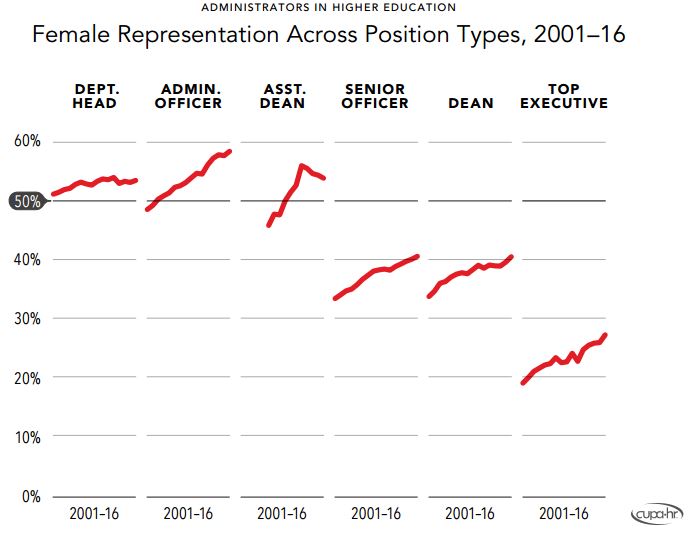
Although there are fewer women in top-paying positions, those who hold those jobs generally experience a narrower pay gap. Women top executives earn more than 90 cents on the dollar when compared to men. Department heads earn only about 85 cents on the dollar.
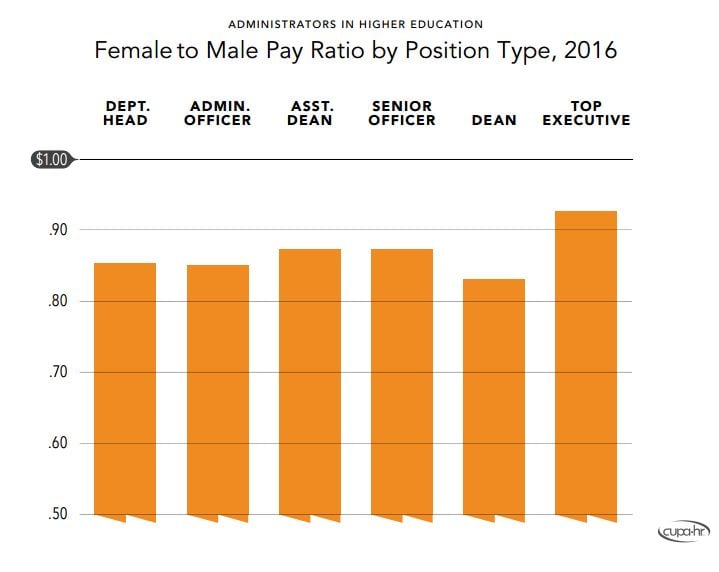
For a few specific positions, like chief facilities officers, women administrators who are steeply outnumbered by men earn more than men. For example, men outnumber women chief facilities officers by a ratio of more than nine to one, but women in such positions make $1.17 for every dollar men make.
That could indicate that institutions are trying to recruit and retain women leaders in positions where they are sharply underrepresented. It appears to be one place higher education stands out from other types of employers, Bichsel said.
“In those positions where women are extremely underrepresented, there does appear to be an effort to pay them more,” she said. “I wasn’t able to find that evidence in private industry. At least in higher ed, there is an effort being made.”
Still, female administrators in many other positions where women are more prevalent are paid substantially less than men in the same roles. Women earn a lower median salary than men in 12 of 15 executive positions reported. In half of those 12 positions, the salary difference is more than 10 percent.
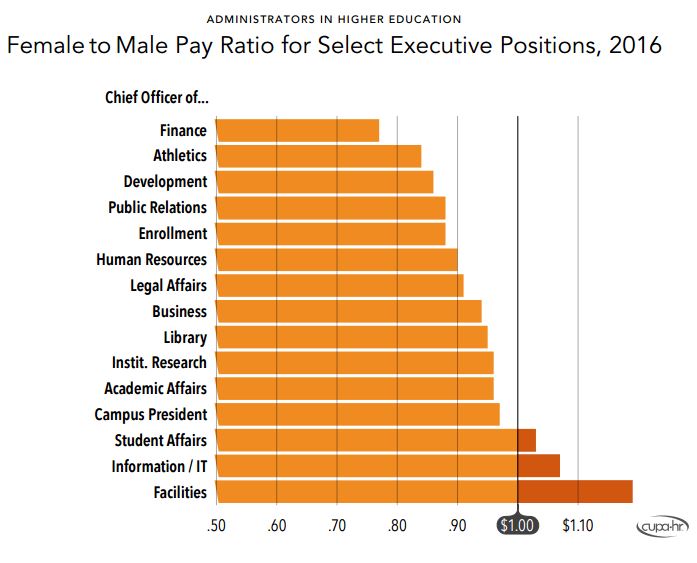
“There might be a perception that they’ve taken care of whatever discrimination might be going on simply by representing women,” Bichsel said. “You can’t lose sight of the fact that we’re still underpaying them even if we’re representing them well.”
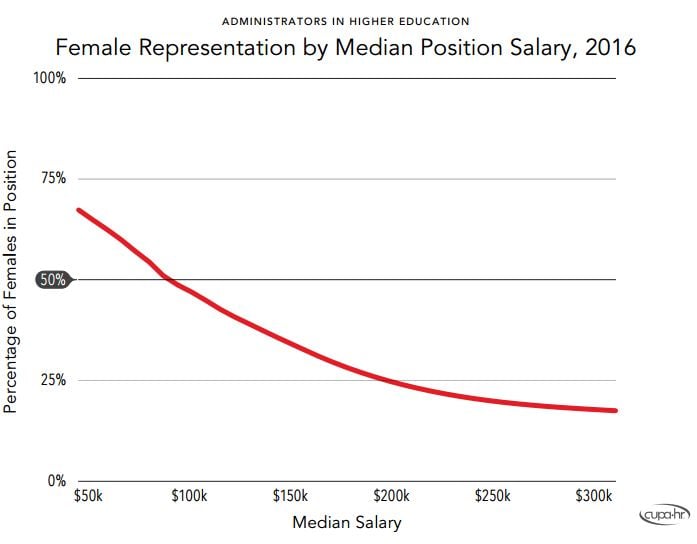
Women aren’t paid highly in all of the roles where they are underrepresented. Women make up just under 40 percent of chief financial officers. But chief financial officers had the highest pay gap between men and women, with women making just 77 cents for every dollar men made.
Women hold more than half of the available jobs in only a handful of executive positions: human resources, libraries, public relations, institutional research and student affairs. Women make up more than 70 percent of administrators in only one of those areas, human resources. Meanwhile, male presidents outnumber female presidents by a ratio of more than two to one. Male chief information officers and chief athletics administrators outnumber women by a ratio of more than four to one.
Breaking down the administrative pay gap by years of service showed the gap decreasing as seniority rose -- up to a point. The pay gap began increasing again for women with more than 17 years of service. Several factors could be behind that trend, including more barriers for women from older generations, ageism and a general U.S. pay gap that is wider for older women, according to CUPA-HR.
The higher ed administrative pay gap varies little by region, CUPA-HR found. The Midwest has closed it the most in the last 15 years, with women’s pay rising by 8 cents on the dollar men earn, from 74 cents to 82 cents. The West, which had the highest women-to-men pay ratio in 2001 -- more than 80 cents on the dollar at the time -- has gone through the least change since then.
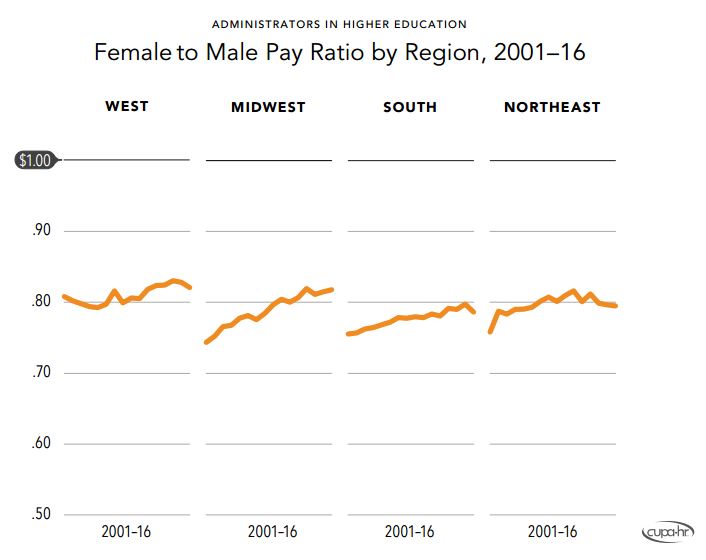
CUPA-HR suggests institutions examine their own data to determine how well women are represented and compensated in administrative positions.


Nenhum comentário:
Postar um comentário